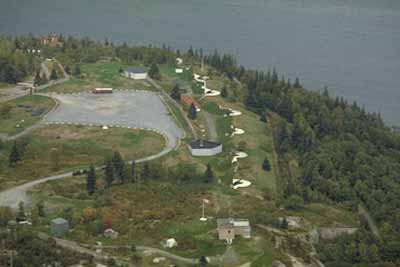York Redoubt National Historic Site of Canada
Halifax, Nova Scotia

York Redoubt
© Parks Canada Agency/Agence Parcs Canada
Address :
Shore Road and Purcell's Cove Road, Purcell's Cove, Halifax, Nova Scotia
Recognition Statute:
Historic Sites and Monuments Act (R.S.C., 1985, c. H-4)
Designation Date:
1965-05-17
Dates:
-
1793 to 1793
(Construction)
-
1794 to 1794
(Significant)
-
1812 to 1814
(Significant)
-
1863 to 1875
(Significant)
-
1890 to 1899
(Significant)
-
1940 to 1943
(Significant)
Other Name(s):
-
York Redoubt
(Designation Name)
Research Report Number:
1962-074, 1964-013, 1999-A02
DFRP Number:
02893 00
Plaque(s)
Existing plaque: Shore Road and Purcell's Cove Road, Halifax, Nova Scotia
York Redoubt was the heart of the defences protecting the outer harbour approaches to Halifax. Begun in 1793, it was enlarged by the Duke of Kent who constructed a Martello tower here in 1798. The redoubt became an essential link in the communications system protecting the city against surprise attack. Its strategic importance was such that it was rebuilt in the 1860s and 1880s to mount more powerful guns. In the twentieth century York Redoubt became the tactical command centre for all harbour defences. It remained active until 1956.
Description of Historic Place
York Redoubt National Historic Site of Canada is comprised of a large, cleared plateau on the west side of Halifax's inner harbour opposite McNabs Island and a gun battery and searchlight positions located close to sea level, reached by a path. The redoubt contains some 27 buildings, related structures, and armament developed over 150 years. The upper portion of the redoubt is located high above wooded cliffs, overlooking the entrance to Halifax harbour which it has protected since the late 18th century.
Heritage Value
York Redoubt was declared a national historic site for its evolving role as part of the Halifax Defence System from the late 18th century to World War II in protecting the principal naval stations of the British Empire and of Canada.
The heritage value of York Redoubt lies in its physical illustration of the historical evolution of the Halifax harbour defence system. York Redoubt was first developed as a component of Halifax fortifications in 1793 by the British government. Major alterations to its facilities occurred in 1794, 1812-1814, 1863-1875, 1890-1899, 1940-1943. It was opened for visitation as a national historic site in 1968.
Sources: HSMBC Minutes, November 1962, May 1965; Commemorative Integrity Statement, 1999.
Character-Defining Elements
Key features contributing to the heritage value of this site include:
the quality and completeness of the cultural landscape which contains extant buildings, ruins, gun emplacements, searchlights, and position finding equipment associated with different defence systems over one and a half centuries, the siting on a high bluff commanding the surrounding terrain and overlooking the harbour entrance and McNabs Island, the siting of the gun and searchlight positions at the bottom of the cliff, close to sea level, the natural landscape of a rocky bluff with a treed slope extending to an exposed shoreline, viewplanes to the harbour entrance and its inner passage, the spatial relationship of the various defence facilities including the Martello tower, the RML armament and its improved 1885 emplacements, range finding technology, the Fire Command Post at Spion Kop, the breech-loading guns and their respective fire control systems, searchlight batteries, submarine mining and net defences, the found form, massing, materials and craftsmanship of the fortifications, buildings and other structures which reflect their military design and construction over the various periods of site use, location and physical remains of shore defences, including an 18th-century martello tower, 19th-century building and structure, gun emplacements, fire control systems, 20th-century searchlights and submarine mining and net defences, archaeological remnants of usage and former installations.